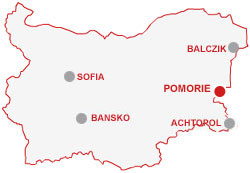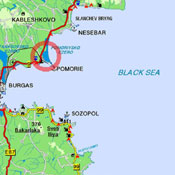Pomorie
Area Description
 The town of Pomorie (population: 15,000) is situated on a narrow and rocky peninsula, bordered by the sea on one side and by the Pomorie lake - on the other. It is situated some 18km north of connecting Bourgas and roughly the same distance south of connecting Nessebar.
The town of Pomorie (population: 15,000) is situated on a narrow and rocky peninsula, bordered by the sea on one side and by the Pomorie lake - on the other. It is situated some 18km north of connecting Bourgas and roughly the same distance south of connecting Nessebar. Pomorie's establishment dates back to the 4th century BC. At that time, Apolonia (present-day connecting Sozopol) built its own colony under the name of Anhialo. A colony of the metropolis of Messembria (present-day connecting Nessebar) was founded here in the 5th century BC. The town gradually worsened its relations with Messembria because the population of the latter was Doric while Anhialo was inhabited predominantly by Ionic people. At that time, the town lived on fishing, mining and salt trading. The shallow waters of the bay secured ideal conditions for that - it was where the town's first settlers discovered layers of salt in the sand. The ancient town was stretching further inland over an area called Paleokastro (meaning Old Fortress), which still holds remains of that time. Anhialo suffered barbarian invasions and in the 8th century it was rebuilt by the Byzantine empress Irina. The town's frequently changed hands but all in all, it was for a longer time under Bulgarian than under Byzantine domination. Similarly to connecting Nessebar, in 1366 Anhialo was conquered and resold to Byzantium by Amadeus of Savoy and his knights. It fell under Ottoman rule together with connecting Nessebar in 1453. After the Liberation the town regained power and was of utmost importance in the Bourgas Bay, having in mind that connecting Bourgas grew into a big city only in the 20th century. At the time of the Liberation, Pomorie had around 12,000 inhabitants or about 4 times the then-population of connecting Bourgas. In 1906 the town caught fire and was almost entirely ruined down save for an ensemble of a few old houses in the eastern part of the town. It is widely known as a salt-mining centre. Abundance of fruit and vegetables has spurred the development of wine production and canning industries.
Besides its lovely beaches, the town appeals to tourists with its mud-cure sanatorium built about 2km away from the town on the banks of the Pomorie lake. The curative features of the lake's mud were discovered already in the 3-4th century BC, though the first mud-cure establishment was built here in 1902. The mud eases bone and muscular disorders, radiculitis, rheumatism, sciatica, lumbago, discal hernia, etc. As regards historical monuments, two old churches - the Transfiguration Church (dating back to the 18-19th century) and the Assumption Church (19th century) - are well preserved. The Transfiguration Church has a valuable wood-carved iconostasis. Moreover, a stone bas-relief of St. Georgi is preserved in the St. Georgi the Victorious Monastery of Pomorie, located in the very centre of the town and build in the 17th century.
Outside the town, a domed tomb-mausoleum (3rd-4th century) built to host the corpse of a high-ranking Thracian, can be found in the area of Kouhata Mogila near the Europa Camping. It is interesting for its construction, as it consists of a tunnel leading to round camera. The tomb is open to visitors. The village of Sarafovo is 6km south of Pomorie. The village is situated on the coast and offers pleasant beaches as well. The natural reserve of the Atanassovo lake is located to the south of Sarafovo in a large lagoon. Once the lake was nestling place for hundreds of birds, though the construction of the Bourgas Airport on one side and the development of the city of connecting Bourgas on the other have gradually reduced this role of its.













